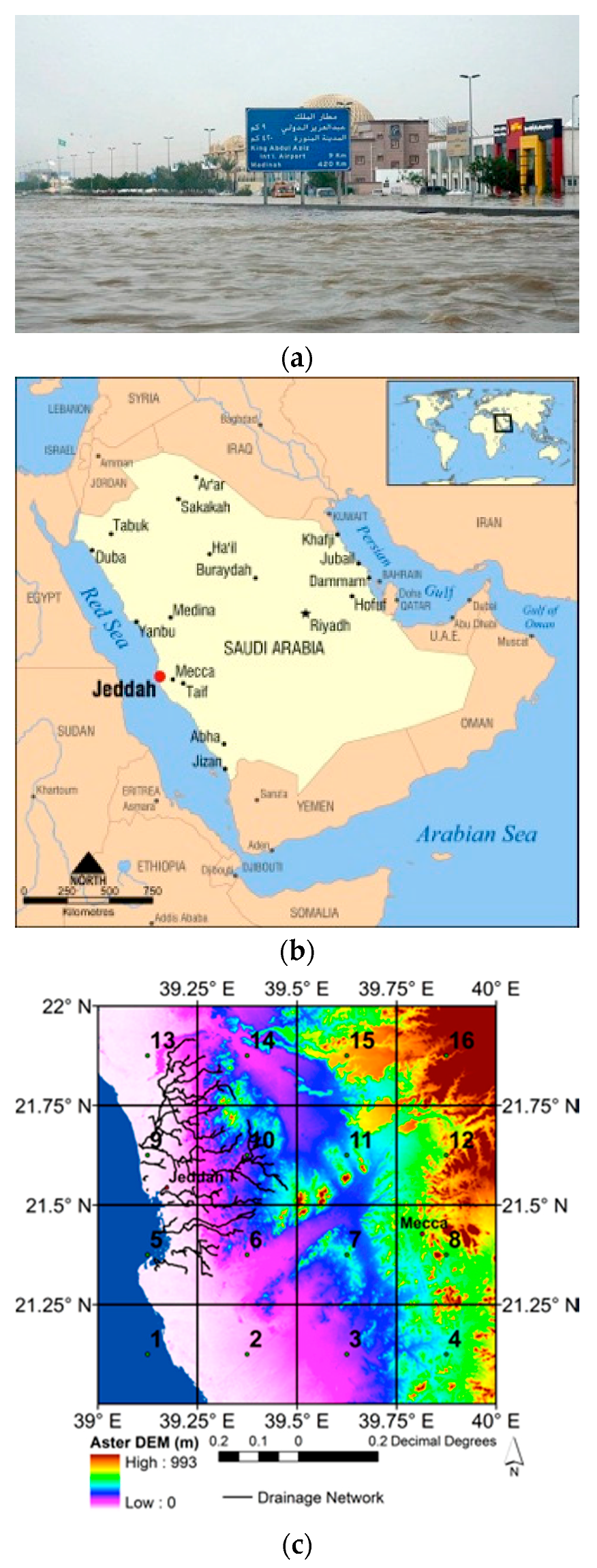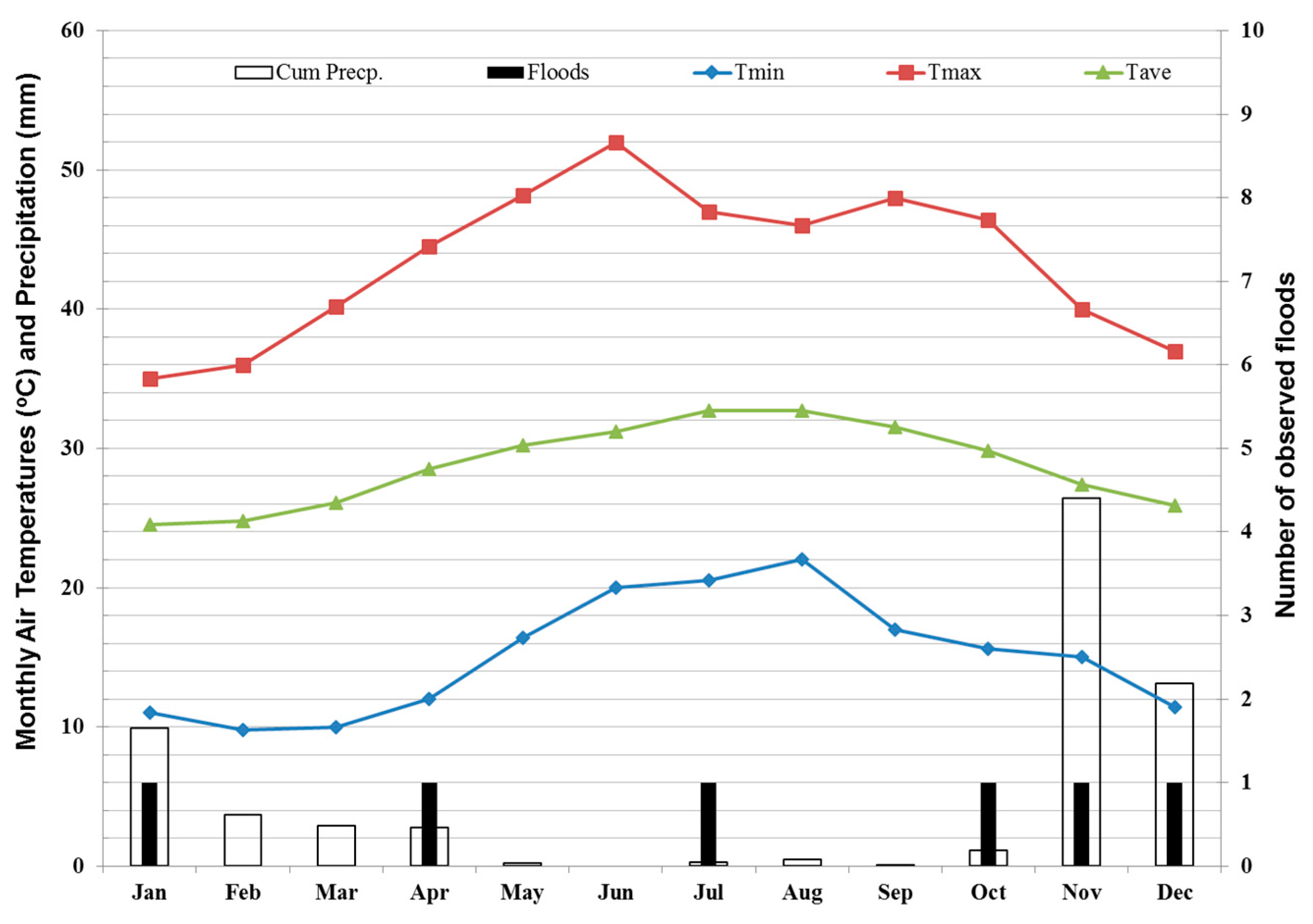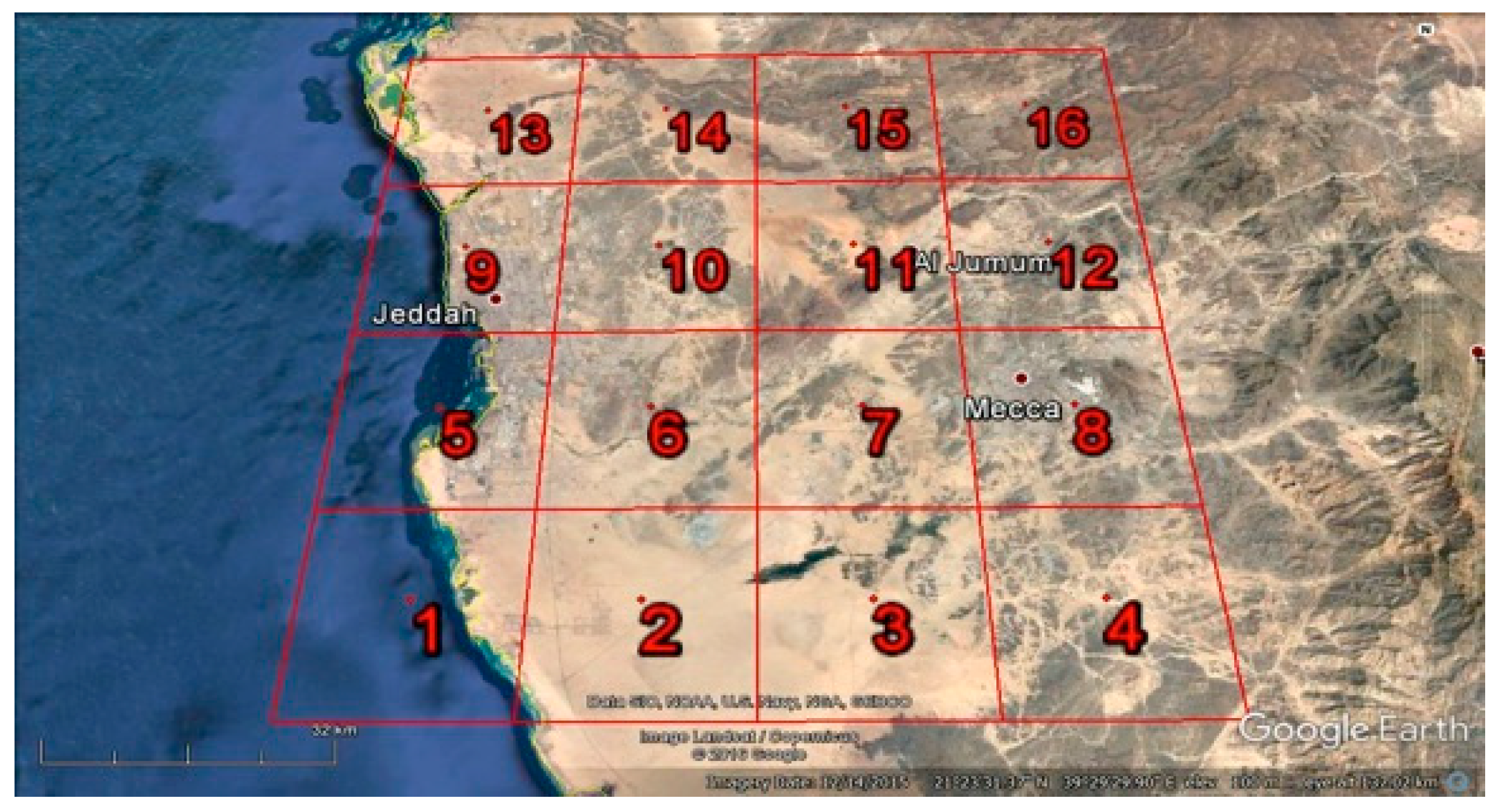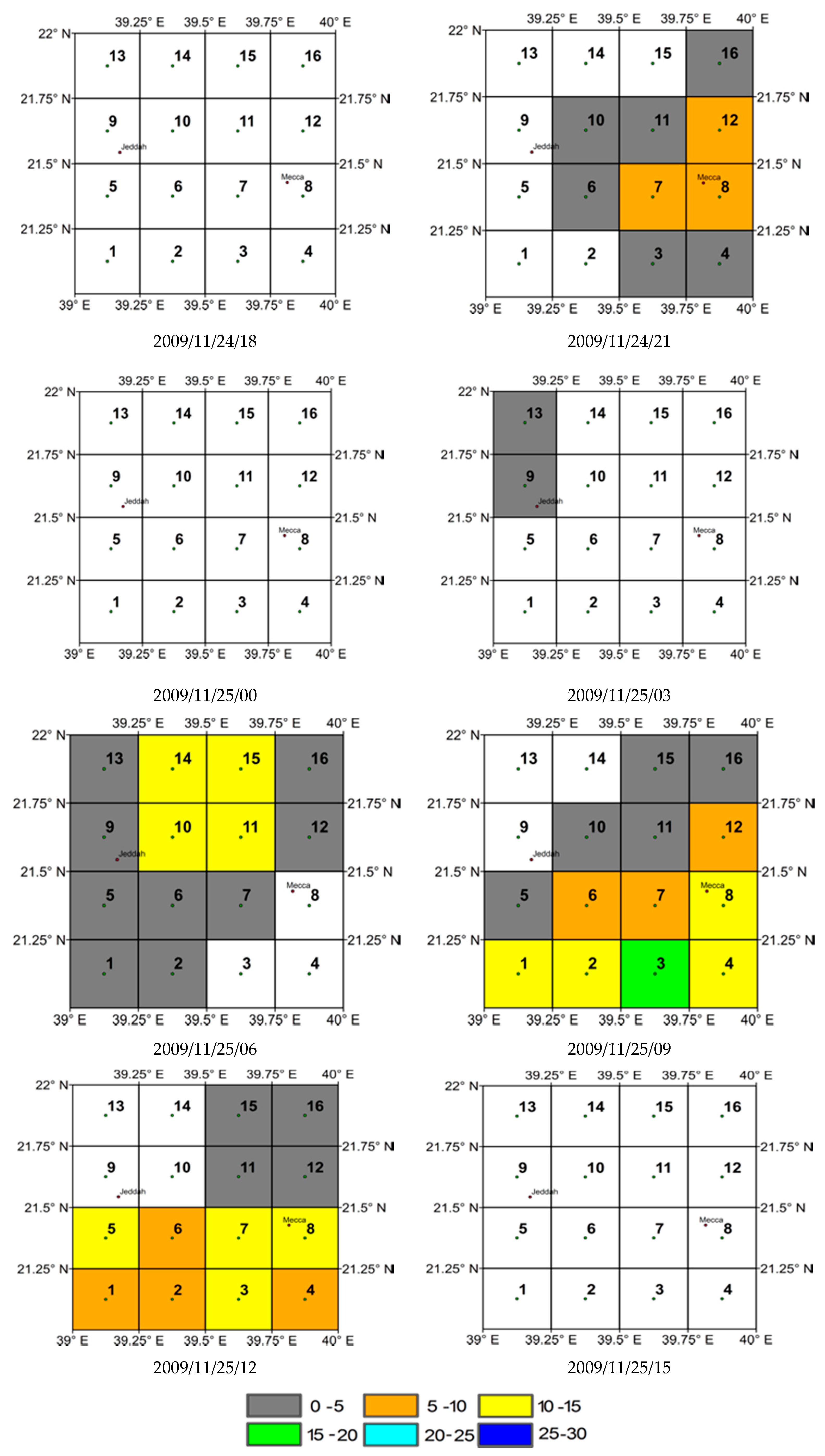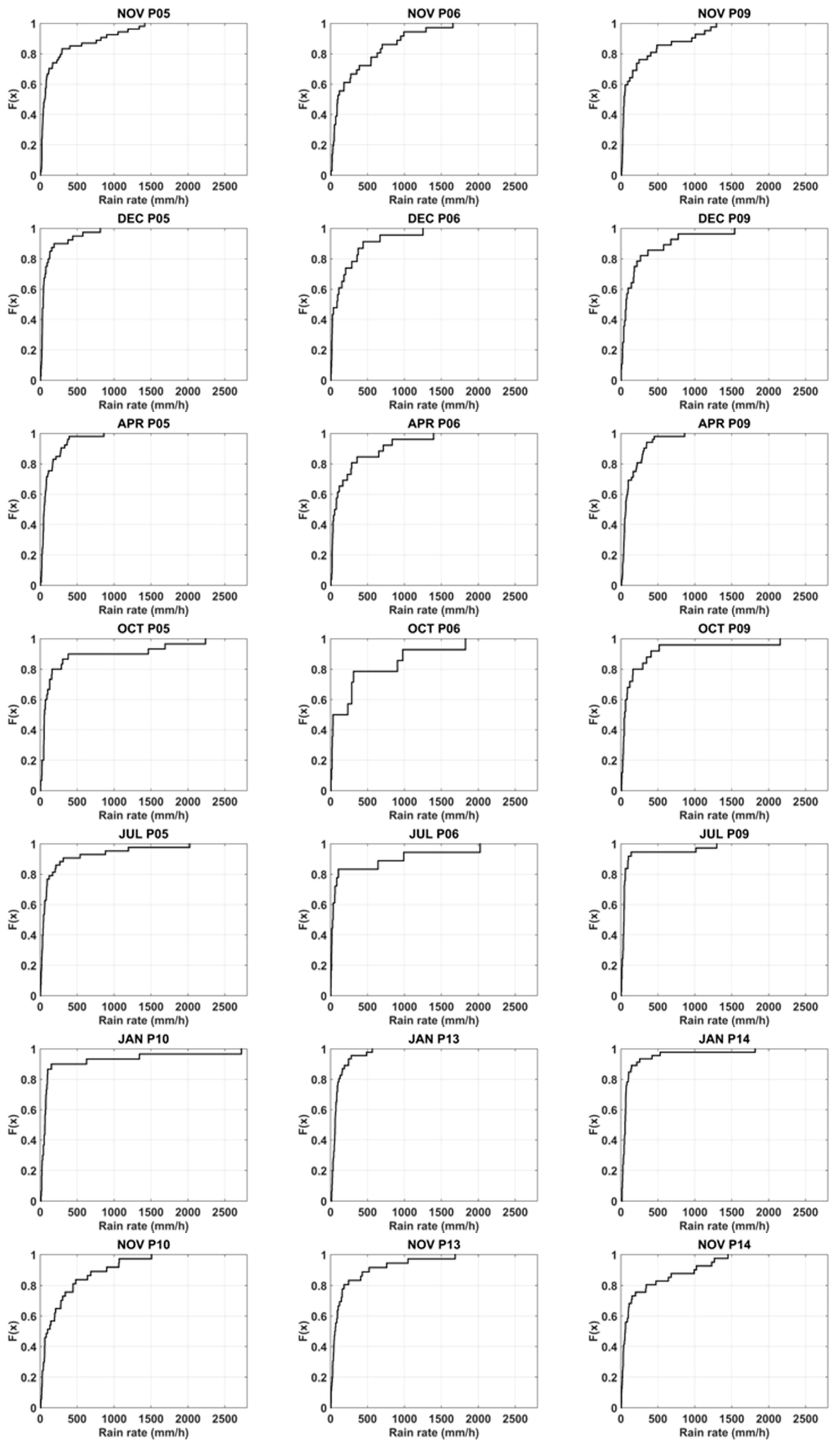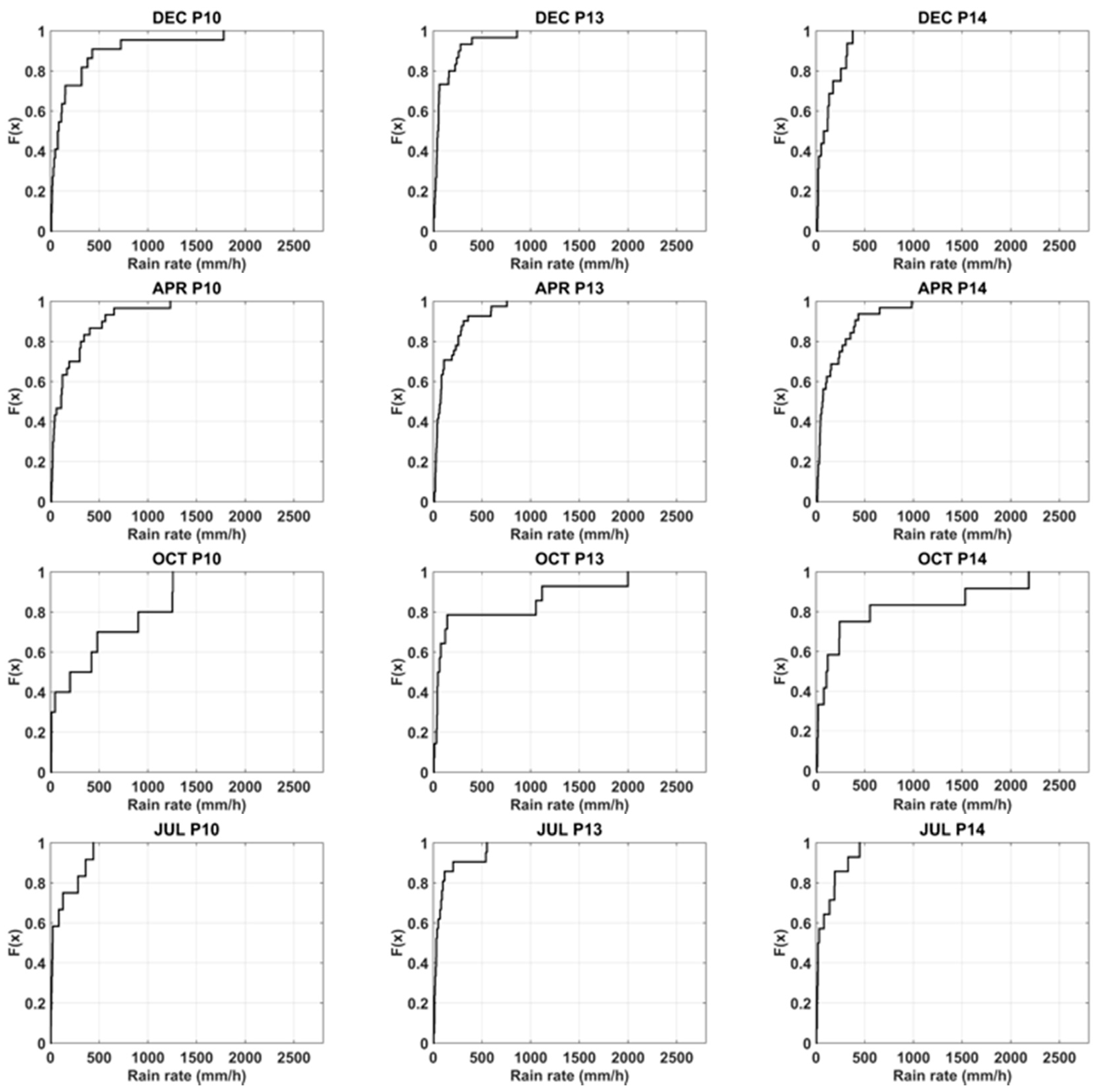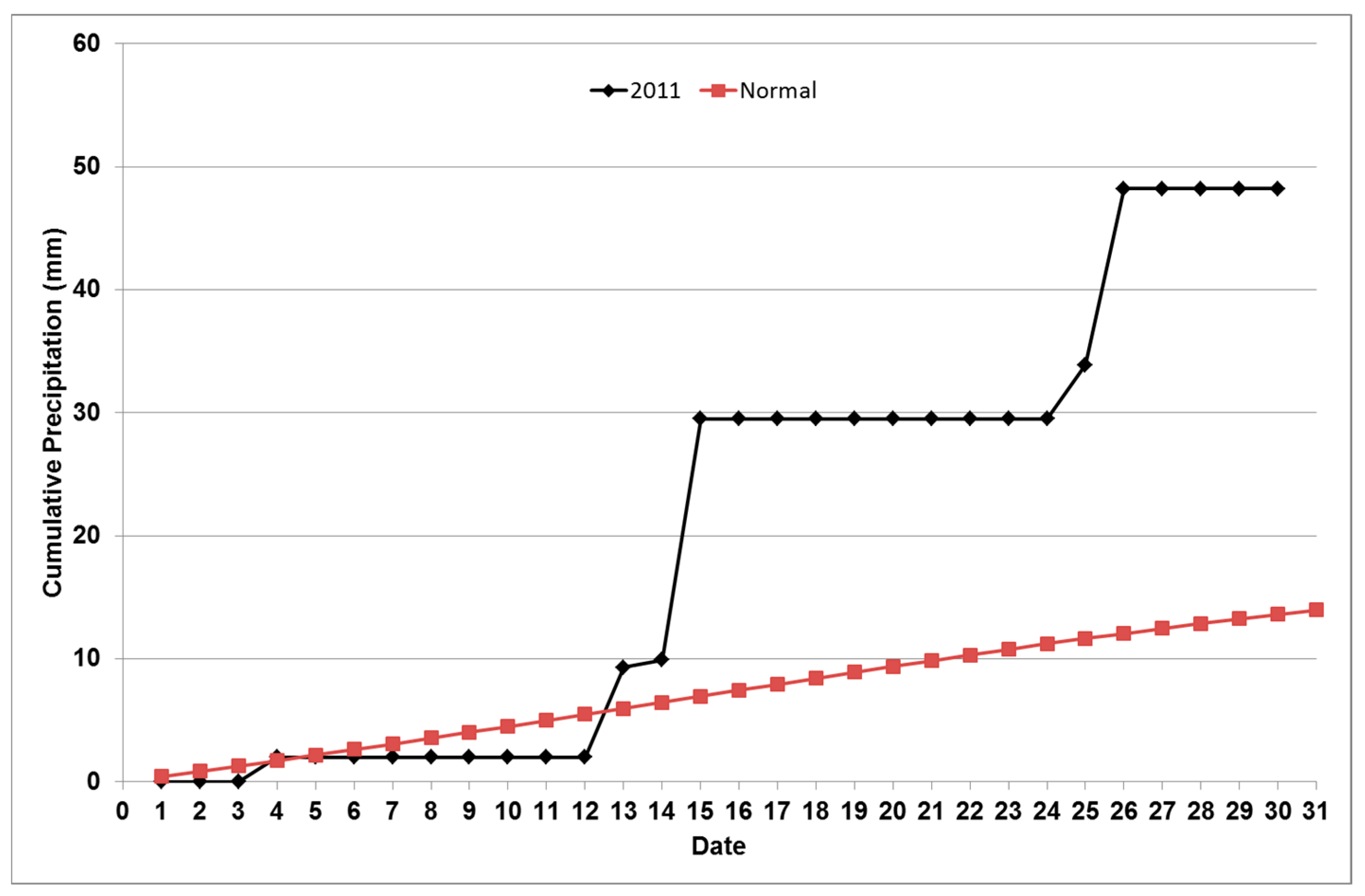1. Introduction
Disasters, which can be categorized as either man-made or natural, are defined as events or dangerous cases that may lead to injury or loss of human life with/without property loss [
1] in addition to the interruptions they cause on human activities [
2]. Out of 31 natural disasters, 28 are the result of meteorological events [
3]. Among these 28 meteorology-based disasters, floods are the most common [
4]. Despite the limited areas in which they occur [
5], flash floods are the most commonly faced, the most deadly and the most challenging [
6,
7]. It is the limited response time that makes flash floods challenging. Hapuarachi et al. [
8] identified excess rainfall as the main driving mechanism for flash floods.
The vulnerability of arid and semi-arid regions to flash floods has been indicated to be equal to that of regions with heavy rain. Moreover, Zipser et al. [
9] mentioned the occurrence of the strongest convective storms, and Haggag and El-Badry [
10] indicated the rapid formation of flash floods in arid and semi-arid regions. The Kingdom of Saudi Arabia (KSA) is well known for its dry climatic conditions [
11] and is classified as a semi-arid region [
12,
13]. However, the floods that occurred over Jeddah, Makkah and Riyadh in KSA indicate flash floods risks in the semi-arid kingdom (
Figure 1a). The risks as well as the impact of flash floods increase due to the rainfall intensity and lack of mitigation implementations [
11].
Negri et al. [
14] identified the establishment of early warning systems as the most effective way to reduce life and property damage in flash flood cases. Despite improvements in numerical weather predictions, it is not easy to detect flash floods. This situation increases the importance of rainfall observations in flash flood estimations.
Ground-based rain gauges have been the main source of data for rainfall observations. However, as mentioned in Negri et al. [
14], in these ground-based stations, data transfer problems can be seen during flooding events, and maintenance of the stations are needed after flooding [
15]. In addition Borga et al. [
5] indicated the inadequacy of ground-based rain gauges in showing the spatial variability of rainfall. Moreover, insufficiency in spatial and temporal coverage, particularly for rainfall observations over Jeddah, is mentioned in Deng et al. [
16].
Ground radar and satellite-based remote sensing are free from such disadvantages and are being used more frequently in both research and operational applications [
17]. In particular, satellite-based remote sensing provides new techniques to monitor extreme rainfall events in an uninterrupted manner and enables implementation of new flood warning systems [
15,
18]. Rainfall intensities at high spatial (1 km to 10 km) and temporal (30 min–3 h) resolutions can be obtained in near real time [
19]. Borga et al. [
5] mentioned that as remotely sensed precipitation became a major component in flood warning systems, mortality decreased due to timely warnings provided by satellite-based rainfall intensities [
18,
20].
In this study, three different flood indexes, namely, the constant threshold (CT), cumulative distribution functions (CDFs) and Jeddah flood index (JFI) that are based on the Tropical Rainfall Measuring Mission (TRMM) satellite 3B42RT rainfall rates are compared in forecasting of flooding events in Jeddah. Thus, the main objective is assessing the forecasting capabilities of TRMM 3B42RT-based indices in identifying the Jeddah floods.
4. Results and Discussion
Flood events and minimum and maximum rainfall rates obtained from TRMM 3B42RT data are presented in
Figure 6. High rainfall rates matched well with flood events except for August, during which no floods were reported. Moreover, both frequency and magnitude of the high rainfall rates are more common during the high rain season (November, December and January period). Thus, seasonality of rainfall patterns of Jeddah are also detected well by 3B42RT.
It is seen that 3B42RT intensities increase towards to the east of Jeddah (
Figure 4). This is in line with the topography where high mountains on the east cause large amounts of rainfall that flow down quickly to Jeddah city [
16,
24]. Moreover, Haggag and El-Badry [
10] also mentioned that eastern parts of the catchment receive 220mm/year more rainfall than other parts.
For the constant threshold (CT), rainfall rates equal or greater than 10.37 mm/h obtained from Equation (1) were searched for in all three-hour interval 3B42RT TRMM data covering the 2000–2014 period. Tekeli and Fouli [
35] and Hamada et al. [
40] used 90% and 99.9% as threshold values in cumulative distribution functions (CDFs). As an initial value, CDF 90% is used as a threshold value in this study. For each 3-h interval covering the 2000–2014 period, the Jeddah Flood Index (JFI) of the 3B42RT pixels are calculated, and values greater than the threshold value 1, are searched.
Based on the above-mentioned thresholds for each method, estimated flood events are summarized in
Table 4. Estimated events that match with the real flood observations are framed by a thick dark border. CT yielded 20 estimated flood events on 14 different days. This led to the identification of 8 events on 6 days. For CDFs, a 90% thresholds resulted in too many false alarms, especially for January, April and December—all of which are in the high rain season. JFI, with a threshold value of 1.00, yielded the highest number flood estimates. It is easily seen that other than December and January, the observed floods are seen when all CT, CDF and JFI indicated flooding.
Dönmez and Tekeli [
44] reduced false flood alarms by updating the CDF thresholds. Since they knew the places where flooding occurred, they used the CDFs of the respective pixels and performed updates accordingly. Unfortunately, the case is not the same in this study. In the approach proposed by [
35], they used the constant threshold value of (3 mm/h) derived from intensity duration curves to determine the respective CDFs. Similarly, in this study, the value obtained from the intensity duration curve, 10.37 mm/h, is used to determine thresholds. The months October and November indicated values higher than the constant value. Thus, these months were used to derive the new thresholds. New values were determined as 91.68%, 91.62%, 93.74%, 87.30%, 88.87% and 87.46% for respective pixels 5, 6, 9, 10, 13 and 14. The first three values (91.68%, 91.62%, 93.74%) are within the 90–99.9% range mentioned in [
35,
40]. However, the last three (87.30%, 88.87% and 87.46%) are not within the range. Using these as thresholds and using the respective months’ CDFs, flood estimations of the CDF-based method are updated. In addition, JFI values are also updated based on the actual flood occurrences. Estimated flood events based on updated thresholds are presented in
Table 5. Both updates drastically reduced false flood alarms.
Table 6 summarizes the estimated number of flood alarms before and after updating under “Estimated/Updated” columns for CDF and JFI and under “Detected” columns number of missed, false and true detection number is presented for CT, CDF and JFI.
Table 6 indicates that CT, CDF and JFI estimated 14, 28 and 20 flood-affected days (FADs) where 6, 8 and 7 matched with actual FADs. CT, with a ratio of 6/14, seems to be superior to CDF (8/28) and JFI (7/20). However, as CT missed January and December floods, the second best, JFI, is selected as the main flood estimation index.
For the 14 January 2011, all indexes (
Table 5, CT, CDF, JFI) indicated flooding. However, nothing was mentioned in the published literature. However, as can be seen from the cumulative precipitation figure (
Figure 7) for the World Meteorological Organization (WMO) station 41024, which is located in Jeddah, heavy rains were recorded. Also, video clips dated the 14 January 2011 are found on the internet (
https://www.youtube.com/watch?v=TiA1AhWrZTs and
https://www.youtube.com/watch?v=1mgDiQ4iDUg) showing the flooded streets. Thus, the event on the 14 January 2011 can be treated as a correct detection. Moreover, the TRMM 3B42RT rainfall rates for the 25–26 January 2011 were lower than those for the 14 January 2011.
This is evident from the case that only CDF and JFI indicated flooding for the 25 January 2011. Despite the smaller rainfall intensities, the flood (25–31 January 2011) damage seemed more extensive than on the 14 January 2011. This might have occurred due to soil being saturated by rainfall on the 14 January 2011. Soil moisture is indicated as the second major flood triggering component, and the effect of soil moisture on flood estimations over Riyadh city is shown in [
46].
Table 7 shows the flood estimations based on the updates (
Table 5) and rain observations for WMO station 41024. In
Table 7, flood observed dates are indicated in black boxes. Unfortunately, data for WMO 41024 are available back to 2008 on the website [
47].
Table 7 indicates that for CT, 5 out of 6 days; for CDF, 9 out of 14 days; and for JFI, 7 out of 8 days of rain were observed at WMO station 41024. These high detection rates (0.83, 0.64 and 0.88) for CT, CDF and JFI, respectively, show the dependability of the methods. Higher detection rates of JFI with respect to CT support JFI being better in flood estimations.
5. Conclusions
This is the first study to show that during floods in Jeddah, TRMM 3B42RT indicated high rainfall intensities. In addition, the seasonal variation of flood occurrences could be represented by 3B42RT data. Moreover, the rainfall timing and rates seemed to match the Weather Research Forecasting (WRF) Model simulations performed by [
16]. The movements of storms from the northwest to southeast seen in 3B42RT images were in parallel with the model results of [
16].
Using 3B42RT data, three different indices, constant threshold (CT), cumulative distribution functions (CDFs) and Jeddah Flood Index (JFI), were developed and compared for Jeddah flood detection capability. For the whole TRMM 3B42RT data period, i.e., 2000–1014, CT, CDF and JFI estimated 14, 28 and 20 flood affected days (FADs) where 6, 8 and 7 matched with actual FADs, leading to detection ratios of 6/14, 8/28 and 7/20, respectively. WMO has a station in Jeddah (with id: 41024); on the web, these data go back to 2008. After 2008, CT, CDF and JFI showed 6, 14 and 8 FADs where 5, 9 and 7 days of these, respectively, matched with 41024 rain records. Despite the higher 6/14 ratio of CT, since CT missed January and December floods and because of the higher rain match ratio of JFI with 41024, JFI is considered as the best index to indicate floods in Jeddah.
Accuracy assessments of all three methods were performed by using the flood information obtained from International Disasters Database and by combining information obtained from various papers. Thus, the accuracy of flood information (both location and time) is very important for valid assessments. The need for good documentation of flood events was also mentioned in [
22].
Rainfall rate is one of the various flood triggering mechanisms considered in this study. Other parameters such as soil moisture (SM), land use and topography can be helpful in accurate flood predictions. Reductions in false flood alarms by using ancillary soil moisture information in flood estimations was presented by [
46]. The occurrence of the 25–31 January 2011 flood despite its lower rainfall rates with respect to the 11–14 January 2011 3B42RT rainfall rates indicate the importance of SM. Thus, future flood estimation studies should consider incorporating SM values.
The task of TRMM has already been terminated. Nevertheless, the methodology presented can be implemented in follow-up missions such as the Global Precipitation Measuring Mission (GPM).
